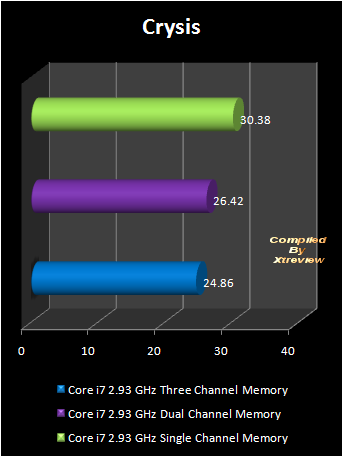I'd trust Lavalys/Sandra more than Superpi, to be honest, especially when you want to put a number on the performance scaling of brand new technology. Superpi is good if you want to compare technology you understand, not really that good if you don't know the technology by heart.
Bios release is a possibility, but I can't understand why Intel would send out motherboards that don't feature the benefits of triple channel right away. This is one of the KEY features of the X58/Nehalem platform, it wouldn't make any sense.
In addition, even if the bios isn't ready, why would Intel keep this information internal? They know people will focus on this features, why on earth would they choose for the path that leads to bad publicity when different reviewing websites claim triple channel just doesn't work.
Different settings, different results. All I know is that the results of the triple channel that we see now is way too low to be correct. And if they are correct ...

Just got the QPI performance scaling confirmed by another source, so I wonder what tests you ran ;-).
This makes me certain that I'll need a setup myself to test everything out. Why oh why did I pass for the Madshrimps Nehalem coverage ...

Actually, I was comparing with NF2, because that's when I first experienced the benefit of dual channel, just like the Core I7 is the first platform that uses triple channel.
I was running 260+ FSB, maybe not such a fair comparison.
To be honest, I should re-read some reviews to draw a decent conclusion, but I think you get my point when I show you the table with 0% improvement going from dual to triple channel. In the past we always DID notice the bandwidth increasements, 'we' as in the (extreme) overclockers. The fact that we are NOT noticing them at the moment is a sign.
In real-life applications, I don't even worry about dual channel. You're not going to notice anything when opening Internet Explorer or Word, but you will notice when you run resource hungry programs such as video encoding or data compression programs. But isn't the Core I7 / X58 platform designed for the normal end-user? I don't see why you bring up the 2S server example, because it has nothing to do with dual/triple channel working or not.
My question is why we don't see any improvement in benchmarks, which very often extrapolate the differences in performance. When we see differences in benchmark utilities, we can be sure (or not) if technology is working, even at 12GB/s.
No idea why they are not clocked exactly the same, not my benchmarks anyway. The small difference in frequency is NOT the reason why the differences in performance are this small, though ;-).
And yeah, the xtreview benchmarks are screwed, I think.







 Reply With Quote
Reply With Quote





 (kidding! don t shoot!)
(kidding! don t shoot!)




 .
.




Bookmarks